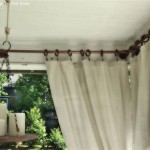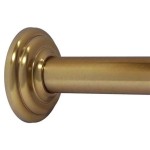How To Hang Bay Window Curtains
Bay windows, renowned for their architectural charm and ability to flood a room with natural light, present a unique challenge when it comes to window treatments. Unlike standard windows, bay windows consist of multiple panes, typically arranged in a curved or angled configuration. This design necessitates a specialized approach to curtain installation to ensure functionality, aesthetics, and proper light control. This article will provide a comprehensive guide to hanging curtains on bay windows, addressing key considerations and offering step-by-step instructions for a successful installation.
Before embarking on the installation process, it is crucial to carefully assess the existing bay window structure and determine the desired aesthetic. Several factors influence the choice of curtain rod and hanging method, including the window's dimensions, the style of the room, and the preferred level of light obstruction.
Selecting the Right Curtain Rod for a Bay Window
The curtain rod is the foundational element for any window treatment. For bay windows, specialized rods are available to accommodate the unique angles and curves inherent in their design. These rods typically come in three primary configurations: sectional rods, flexible rods, and custom-bent rods. The selection process should consider both the practical and aesthetic aspects of each type.
Sectional rods consist of multiple straight rod segments connected by elbow joints. These joints are adjustable, allowing the rod to conform to the specific angle of the bay window. Sectional rods are a versatile and relatively affordable option, suitable for a wide range of fabric weights and curtain styles. However, the connection points can sometimes be visible, which may detract from the overall aesthetic. When using sectional rods, accurate measurement of each window section is paramount to ensure a seamless fit. Furthermore, the strength of the elbow joints should be considered, especially when hanging heavier curtains.
Flexible curtain rods are crafted from a malleable material that can be bent and shaped to perfectly match the contours of the bay window. These rods offer a clean, continuous appearance and eliminate visible joints. Flexible rods are particularly well-suited for windows with curved or irregular shapes. However, they may not be able to support extremely heavy curtains and are generally more expensive than sectional rods. Installation of flexible rods requires careful handling and precise bending to achieve the desired shape. It is recommended to use a template or guide to ensure accuracy.
Custom-bent rods are fabricated to the exact specifications of the bay window. This option provides the most seamless and professional-looking result, as the rod is precisely tailored to the window's dimensions and angles. Custom-bent rods are typically made from sturdy materials, capable of supporting heavier curtains. However, they are the most expensive option and require professional measurement and installation. Accurate measurements are critical for custom-bent rods, as any discrepancies will result in a rod that does not fit properly.
In addition to the type of rod, the diameter of the rod should be considered. Thicker rods generally provide greater support for heavier curtains, while thinner rods may be more suitable for lightweight fabrics. The finish of the rod should also complement the room's décor and the curtain fabric.
Measuring and Planning the Installation
Accurate measurements are essential for a successful bay window curtain installation. The dimensions of each window section, the angles between the sections, and the desired curtain height must be precisely determined. The installation process should be planned meticulously, taking into account the locations of studs or other structural supports in the wall or ceiling.
Begin by measuring the width of each individual window section within the bay window. These measurements will determine the required length of each rod segment for sectional rods or the overall length of a flexible or custom-bent rod. Use a flexible measuring tape to accurately follow the contours of the window frame. It is advisable to take multiple measurements and use the average to minimize errors.
Next, measure the angles between each window section. A protractor or angle finder can be used to determine these angles accurately. These measurements are crucial for adjusting the elbow joints in sectional rods or for providing the correct specifications for custom-bent rods. Inaccurate angle measurements can result in gaps between the curtain and the window frame, compromising light control and insulation.
Determine the desired curtain height. This measurement will determine the placement of the curtain rod brackets. Consider the overall aesthetic and the desired level of privacy when deciding on the curtain height. Curtains that extend to the floor create a more formal and elegant look, while shorter curtains may be more appropriate for casual spaces. Mark the desired bracket locations on the wall or ceiling, ensuring that they are evenly spaced and aligned.
Before installing the brackets, use a stud finder to locate structural supports in the wall or ceiling. Mounting the brackets directly into studs will provide a more secure and stable installation, especially for heavier curtains. If studs are not available at the desired bracket locations, use appropriate drywall anchors to ensure that the brackets are securely attached. The weight capacity of the chosen anchors should be sufficient to support the weight of the curtains and the rod.
Careful planning and accurate measurements are critical for a successful bay window curtain installation. Taking the time to properly measure and plan will prevent costly mistakes and ensure a professional-looking result.
Step-by-Step Curtain Installation Guide
Once the curtain rod has been selected and the installation has been planned, the actual installation process can begin. The specific steps will vary depending on the type of rod being used, but the following guide provides a general overview of the process.
Step 1: Install the Curtain Rod Brackets. Position the curtain rod brackets at the marked locations on the wall or ceiling. Use a level to ensure that the brackets are horizontally aligned. Secure the brackets to the wall or ceiling using screws. If mounting into drywall, pre-drill pilot holes and insert drywall anchors before attaching the screws. Ensure that the brackets are securely fastened and can support the weight of the curtains and the rod.
Step 2: Assemble and Install the Curtain Rod. For sectional rods, connect the individual rod segments using the elbow joints. Adjust the angles of the joints to match the angles between the window sections. For flexible rods, carefully bend the rod to match the contours of the bay window. A template or guide can be used to ensure accuracy. For custom-bent rods, simply position the rod in the brackets. Once the rod is assembled and shaped, carefully lift it into place and position it in the brackets. Ensure that the rod is securely seated in the brackets.
Step 3: Hang the Curtains. Depending on the type of curtain, attach the curtain hooks or rings to the curtain rod. Ensure that the curtains are evenly spaced and that they hang properly. Adjust the hooks or rings as needed to achieve the desired drape and fullness.
Step 4: Test and Adjust. Once the curtains are hung, test them to ensure that they slide smoothly along the rod. Adjust the brackets or the rod as needed to ensure smooth operation. Check the light control and privacy provided by the curtains. Make any necessary adjustments to the curtain height or fullness to achieve the desired level of light obstruction and privacy.
Following these steps will result in a successfully installed bay window curtain. The chosen curtain should enhance the aesthetic of the room while also providing functionality and light control.
The successful hanging of bay window curtains depends on careful planning, accurate measurements, and the selection of appropriate materials. While the task presents unique challenges compared to standard windows, the effort invested results in enhanced visual appeal and functional benefits, ultimately transforming the space into a more comfortable and aesthetically pleasing environment.

How To Hang Curtains In A Bay Window Thistlewood Farm

5 Curtain Ideas For Bay Windows

How To Hang Bay Window Curtains On An Oversized The Organized Mama

How To Hang Curtains In A Bay Window Thistlewood Farm

How To Hang Curtains In A Bay Window And Blinds

Bay Window Curtains Solutions Inspiration The Shade

How Do You Hang Curtains In A Bay Window Decor Snob

How To Dress A Bay Window By Continental Fashions

5 Curtain Ideas For Bay Windows

How To Hang Curtains In A Bay Window








